engine FIAT FULLBACK 2018 Owner handbook (in English)
[x] Cancel search | Manufacturer: FIAT, Model Year: 2018, Model line: FULLBACK, Model: FIAT FULLBACK 2018Pages: 316, PDF Size: 10.52 MB
Page 107 of 316
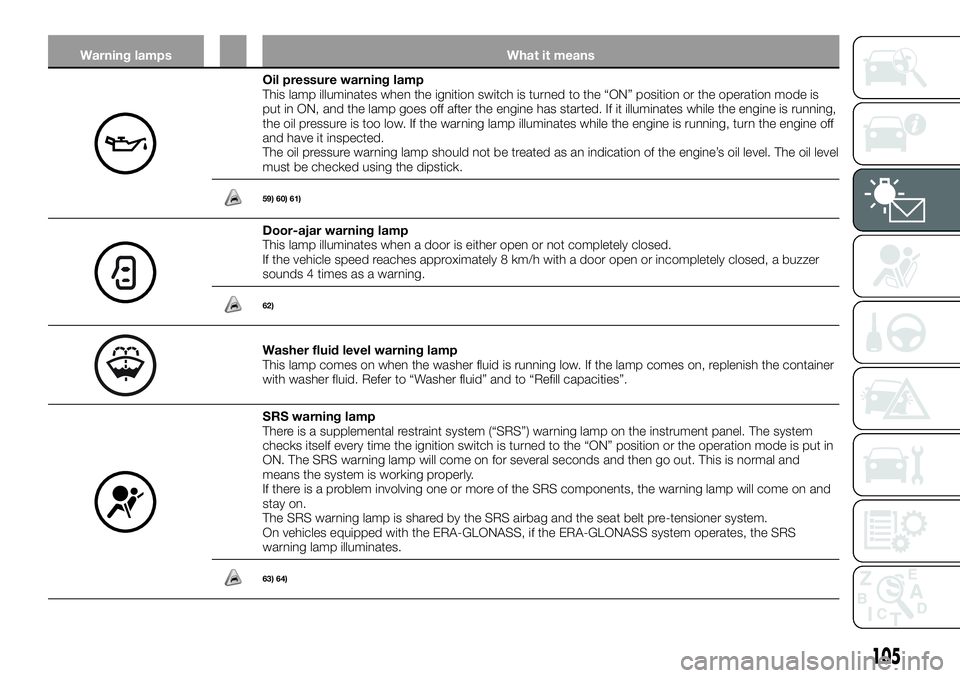
Warning lamps What it means
Oil pressure warning lamp
This lamp illuminates when the ignition switch is turned to the “ON” position or the operation mode is
put in ON, and the lamp goes off after the engine has started. If it illuminates while the engine is running,
the oil pressure is too low. If the warning lamp illuminates while the engine is running, turn the engine off
and have it inspected.
The oil pressure warning lamp should not be treated as an indication of the engine’s oil level. The oil level
must be checked using the dipstick.
59) 60) 61)
Door-ajar warning lamp
This lamp illuminates when a door is either open or not completely closed.
If the vehicle speed reaches approximately 8 km/h with a door open or incompletely closed, a buzzer
sounds 4 times as a warning.
62)
Washer fluid level warning lamp
This lamp comes on when the washer fluid is running low. If the lamp comes on, replenish the container
with washer fluid. Refer to “Washer fluid” and to “Refill capacities”.
SRS warning lamp
There is a supplemental restraint system (“SRS”) warning lamp on the instrument panel. The system
checks itself every time the ignition switch is turned to the “ON” position or the operation mode is put in
ON. The SRS warning lamp will come on for several seconds and then go out. This is normal and
means the system is working properly.
If there is a problem involving one or more of the SRS components, the warning lamp will come on and
stay on.
The SRS warning lamp is shared by the SRS airbag and the seat belt pre-tensioner system.
On vehicles equipped with the ERA-GLONASS, if the ERA-GLONASS system operates, the SRS
warning lamp illuminates.
63) 64)
105
Page 108 of 316
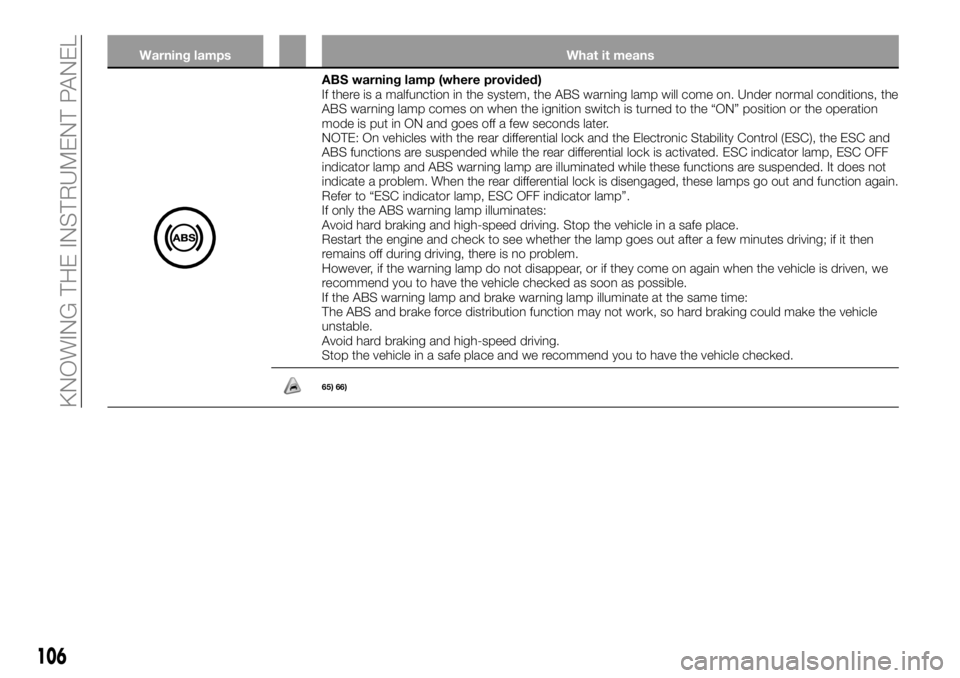
Warning lamps What it means
ABS warning lamp (where provided)
If there is a malfunction in the system, the ABS warning lamp will come on. Under normal conditions, the
ABS warning lamp comes on when the ignition switch is turned to the “ON” position or the operation
mode is put in ON and goes off a few seconds later.
NOTE: On vehicles with the rear differential lock and the Electronic Stability Control (ESC), the ESC and
ABS functions are suspended while the rear differential lock is activated. ESC indicator lamp, ESC OFF
indicator lamp and ABS warning lamp are illuminated while these functions are suspended. It does not
indicate a problem. When the rear differential lock is disengaged, these lamps go out and function again.
Refer to “ESC indicator lamp, ESC OFF indicator lamp”.
If only the ABS warning lamp illuminates:
Avoid hard braking and high-speed driving. Stop the vehicle in a safe place.
Restart the engine and check to see whether the lamp goes out after a few minutes driving; if it then
remains off during driving, there is no problem.
However, if the warning lamp do not disappear, or if they come on again when the vehicle is driven, we
recommend you to have the vehicle checked as soon as possible.
If the ABS warning lamp and brake warning lamp illuminate at the same time:
The ABS and brake force distribution function may not work, so hard braking could make the vehicle
unstable.
Avoid hard braking and high-speed driving.
Stop the vehicle in a safe place and we recommend you to have the vehicle checked.
65) 66)
106
KNOWING THE INSTRUMENT PANEL
Page 109 of 316
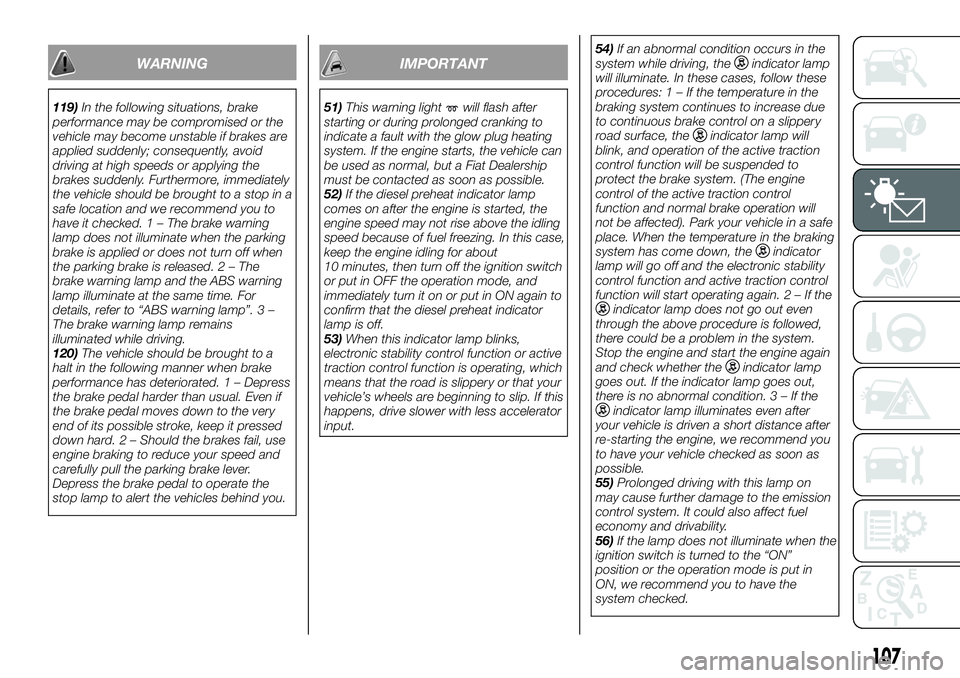
WARNING
119)In the following situations, brake
performance may be compromised or the
vehicle may become unstable if brakes are
applied suddenly; consequently, avoid
driving at high speeds or applying the
brakes suddenly. Furthermore, immediately
the vehicle should be brought to a stop in a
safe location and we recommend you to
have it checked. 1 – The brake warning
lamp does not illuminate when the parking
brake is applied or does not turn off when
the parking brake is released.2–The
brake warning lamp and the ABS warning
lamp illuminate at the same time. For
details, refer to “ABS warning lamp”. 3 –
The brake warning lamp remains
illuminated while driving.
120)The vehicle should be brought to a
halt in the following manner when brake
performance has deteriorated. 1 – Depress
the brake pedal harder than usual. Even if
the brake pedal moves down to the very
end of its possible stroke, keep it pressed
down hard. 2 – Should the brakes fail, use
engine braking to reduce your speed and
carefully pull the parking brake lever.
Depress the brake pedal to operate the
stop lamp to alert the vehicles behind you.
IMPORTANT
51)This warning lightwill flash after
starting or during prolonged cranking to
indicate a fault with the glow plug heating
system. If the engine starts, the vehicle can
be used as normal, but a Fiat Dealership
must be contacted as soon as possible.
52)If the diesel preheat indicator lamp
comes on after the engine is started, the
engine speed may not rise above the idling
speed because of fuel freezing. In this case,
keep the engine idling for about
10 minutes, then turn off the ignition switch
or put in OFF the operation mode, and
immediately turn it on or put in ON again to
confirm that the diesel preheat indicator
lamp is off.
53)When this indicator lamp blinks,
electronic stability control function or active
traction control function is operating, which
means that the road is slippery or that your
vehicle’s wheels are beginning to slip. If this
happens, drive slower with less accelerator
input.54)If an abnormal condition occurs in the
system while driving, the
indicator lamp
will illuminate. In these cases, follow these
procedures:1–Ifthetemperature in the
braking system continues to increase due
to continuous brake control on a slippery
road surface, the
indicator lamp will
blink, and operation of the active traction
control function will be suspended to
protect the brake system. (The engine
control of the active traction control
function and normal brake operation will
not be affected). Park your vehicle in a safe
place. When the temperature in the braking
system has come down, the
indicator
lamp will go off and the electronic stability
control function and active traction control
function will start operating again.2–Ifthe
indicator lamp does not go out even
through the above procedure is followed,
there could be a problem in the system.
Stop the engine and start the engine again
and check whether the
indicator lamp
goes out. If the indicator lamp goes out,
there is no abnormal condition.3–Ifthe
indicator lamp illuminates even after
your vehicle is driven a short distance after
re-starting the engine, we recommend you
to have your vehicle checked as soon as
possible.
55)Prolonged driving with this lamp on
may cause further damage to the emission
control system. It could also affect fuel
economy and drivability.
56)If the lamp does not illuminate when the
ignition switch is turned to the “ON”
position or the operation mode is put in
ON, we recommend you to have the
system checked.
107
Page 110 of 316
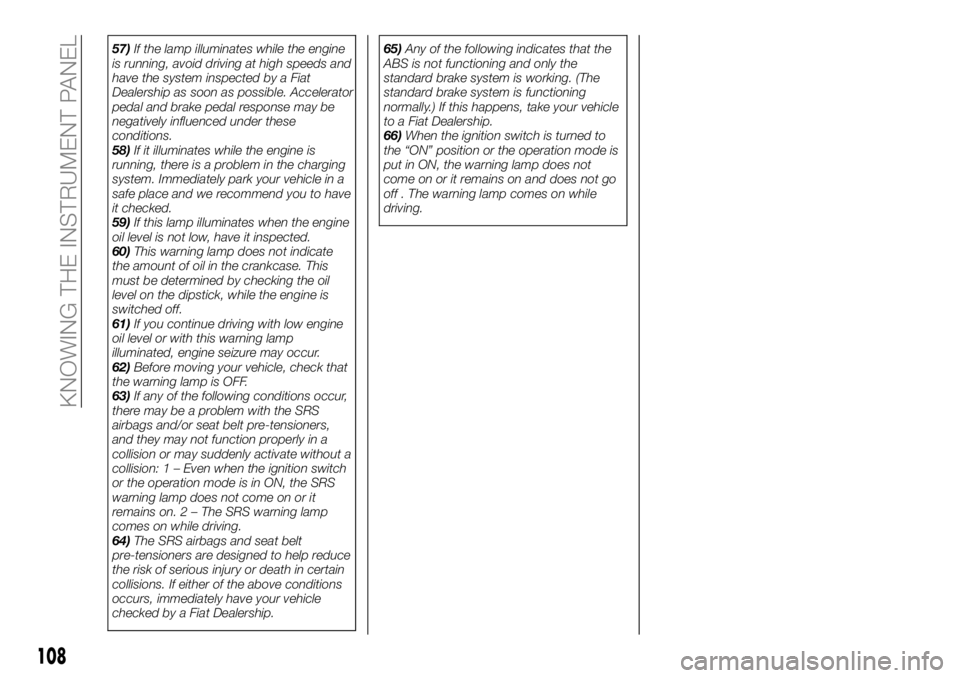
57)If the lamp illuminates while the engine
is running, avoid driving at high speeds and
have the system inspected by a Fiat
Dealership as soon as possible. Accelerator
pedal and brake pedal response may be
negatively influenced under these
conditions.
58)If it illuminates while the engine is
running, there is a problem in the charging
system. Immediately park your vehicle in a
safe place and we recommend you to have
it checked.
59)If this lamp illuminates when the engine
oil level is not low, have it inspected.
60)This warning lamp does not indicate
the amount of oil in the crankcase. This
must be determined by checking the oil
level on the dipstick, while the engine is
switched off.
61)If you continue driving with low engine
oil level or with this warning lamp
illuminated, engine seizure may occur.
62)Before moving your vehicle, check that
the warning lamp is OFF.
63)If any of the following conditions occur,
there may be a problem with the SRS
airbags and/or seat belt pre-tensioners,
and they may not function properly in a
collision or may suddenly activate without a
collision: 1 – Even when the ignition switch
or the operation mode is in ON, the SRS
warning lamp does not come on or it
remains on. 2 – The SRS warning lamp
comes on while driving.
64)The SRS airbags and seat belt
pre-tensioners are designed to help reduce
the risk of serious injury or death in certain
collisions. If either of the above conditions
occurs, immediately have your vehicle
checked by a Fiat Dealership.65)Any of the following indicates that the
ABS is not functioning and only the
standard brake system is working. (The
standard brake system is functioning
normally.) If this happens, take your vehicle
to a Fiat Dealership.
66)When the ignition switch is turned to
the “ON” position or the operation mode is
put in ON, the warning lamp does not
come on or it remains on and does not go
off . The warning lamp comes on while
driving.
108
KNOWING THE INSTRUMENT PANEL
Page 142 of 316
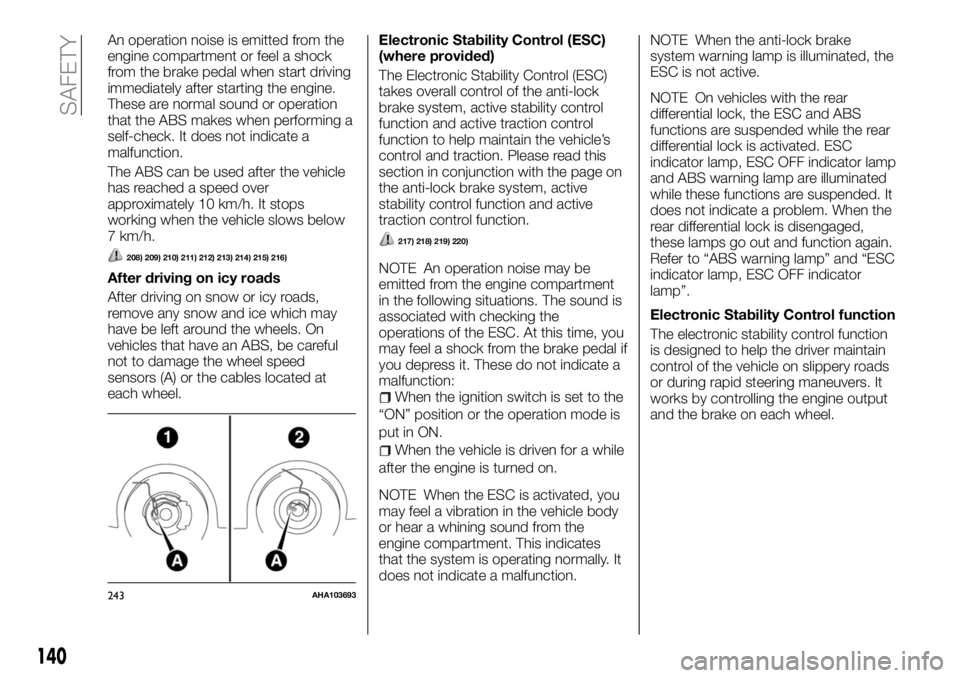
An operation noise is emitted from the
engine compartment or feel a shock
from the brake pedal when start driving
immediately after starting the engine.
These are normal sound or operation
that the ABS makes when performing a
self-check. It does not indicate a
malfunction.
The ABS can be used after the vehicle
has reached a speed over
approximately 10 km/h. It stops
working when the vehicle slows below
7 km/h.
208) 209) 210) 211) 212) 213) 214) 215) 216)
After driving on icy roads
After driving on snow or icy roads,
remove any snow and ice which may
have be left around the wheels. On
vehicles that have an ABS, be careful
not to damage the wheel speed
sensors (A) or the cables located at
each wheel.Electronic Stability Control (ESC)
(where provided)
The Electronic Stability Control (ESC)
takes overall control of the anti-lock
brake system, active stability control
function and active traction control
function to help maintain the vehicle’s
control and traction. Please read this
section in conjunction with the page on
the anti-lock brake system, active
stability control function and active
traction control function.
217) 218) 219) 220)
NOTE An operation noise may be
emitted from the engine compartment
in the following situations. The sound is
associated with checking the
operations of the ESC. At this time, you
may feel a shock from the brake pedal if
you depress it. These do not indicate a
malfunction:
When the ignition switch is set to the
“ON” position or the operation mode is
put in ON.
When the vehicle is driven for a while
after the engine is turned on.
NOTE When the ESC is activated, you
may feel a vibration in the vehicle body
or hear a whining sound from the
engine compartment. This indicates
that the system is operating normally. It
does not indicate a malfunction.NOTE When the anti-lock brake
system warning lamp is illuminated, the
ESC is not active.
NOTE On vehicles with the rear
differential lock, the ESC and ABS
functions are suspended while the rear
differential lock is activated. ESC
indicator lamp, ESC OFF indicator lamp
and ABS warning lamp are illuminated
while these functions are suspended. It
does not indicate a problem. When the
rear differential lock is disengaged,
these lamps go out and function again.
Refer to “ABS warning lamp” and “ESC
indicator lamp, ESC OFF indicator
lamp”.
Electronic Stability Control function
The electronic stability control function
is designed to help the driver maintain
control of the vehicle on slippery roads
or during rapid steering maneuvers. It
works by controlling the engine output
and the brake on each wheel.
243AHA103693
140
SAFETY
Page 143 of 316
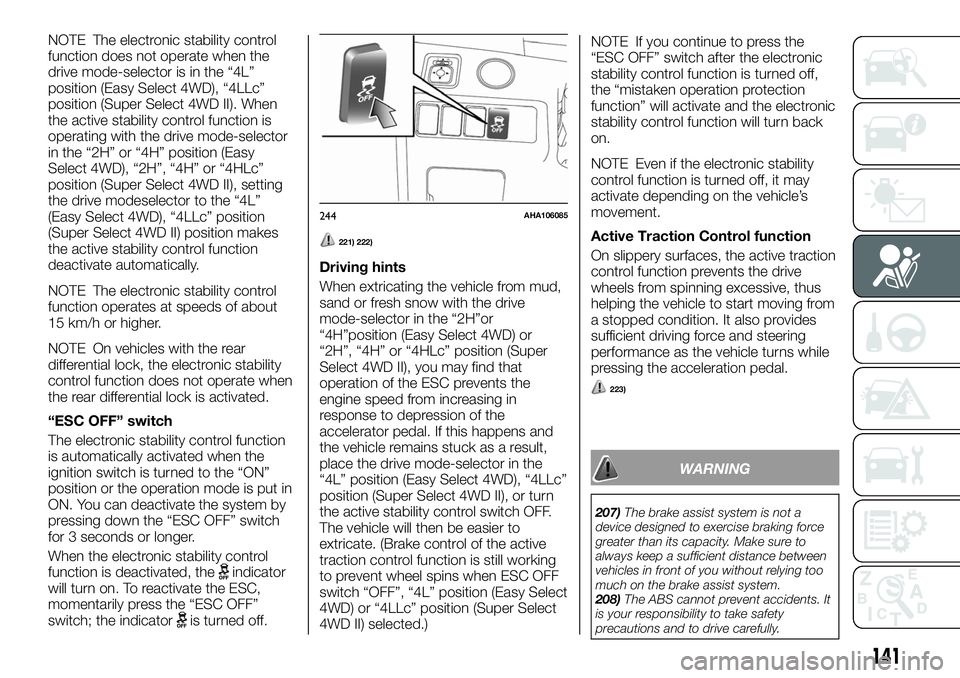
NOTE The electronic stability control
function does not operate when the
drive mode-selector is in the “4L”
position (Easy Select 4WD), “4LLc”
position (Super Select 4WD II). When
the active stability control function is
operating with the drive mode-selector
in the “2H” or “4H” position (Easy
Select 4WD), “2H”, “4H” or “4HLc”
position (Super Select 4WD II), setting
the drive modeselector to the “4L”
(Easy Select 4WD), “4LLc” position
(Super Select 4WD II) position makes
the active stability control function
deactivate automatically.
NOTE The electronic stability control
function operates at speeds of about
15 km/h or higher.
NOTE On vehicles with the rear
differential lock, the electronic stability
control function does not operate when
the rear differential lock is activated.
“ESC OFF” switch
The electronic stability control function
is automatically activated when the
ignition switch is turned to the “ON”
position or the operation mode is put in
ON. You can deactivate the system by
pressing down the “ESC OFF” switch
for 3 seconds or longer.
When the electronic stability control
function is deactivated, the
indicator
will turn on. To reactivate the ESC,
momentarily press the “ESC OFF”
switch; the indicator
is turned off.
221) 222)
Driving hints
When extricating the vehicle from mud,
sand or fresh snow with the drive
mode-selector in the “2H”or
“4H”position (Easy Select 4WD) or
“2H”, “4H” or “4HLc” position (Super
Select 4WD II), you may find that
operation of the ESC prevents the
engine speed from increasing in
response to depression of the
accelerator pedal. If this happens and
the vehicle remains stuck as a result,
place the drive mode-selector in the
“4L” position (Easy Select 4WD), “4LLc”
position (Super Select 4WD II), or turn
the active stability control switch OFF.
The vehicle will then be easier to
extricate. (Brake control of the active
traction control function is still working
to prevent wheel spins when ESC OFF
switch “OFF”, “4L” position (Easy Select
4WD) or “4LLc” position (Super Select
4WD II) selected.)NOTE If you continue to press the
“ESC OFF” switch after the electronic
stability control function is turned off,
the “mistaken operation protection
function” will activate and the electronic
stability control function will turn back
on.
NOTE Even if the electronic stability
control function is turned off, it may
activate depending on the vehicle’s
movement.
Active Traction Control function
On slippery surfaces, the active traction
control function prevents the drive
wheels from spinning excessive, thus
helping the vehicle to start moving from
a stopped condition. It also provides
sufficient driving force and steering
performance as the vehicle turns while
pressing the acceleration pedal.
223)
WARNING
207)The brake assist system is not a
device designed to exercise braking force
greater than its capacity. Make sure to
always keep a sufficient distance between
vehicles in front of you without relying too
much on the brake assist system.
208)The ABS cannot prevent accidents. It
is your responsibility to take safety
precautions and to drive carefully.
244AHA106085
141
Page 145 of 316
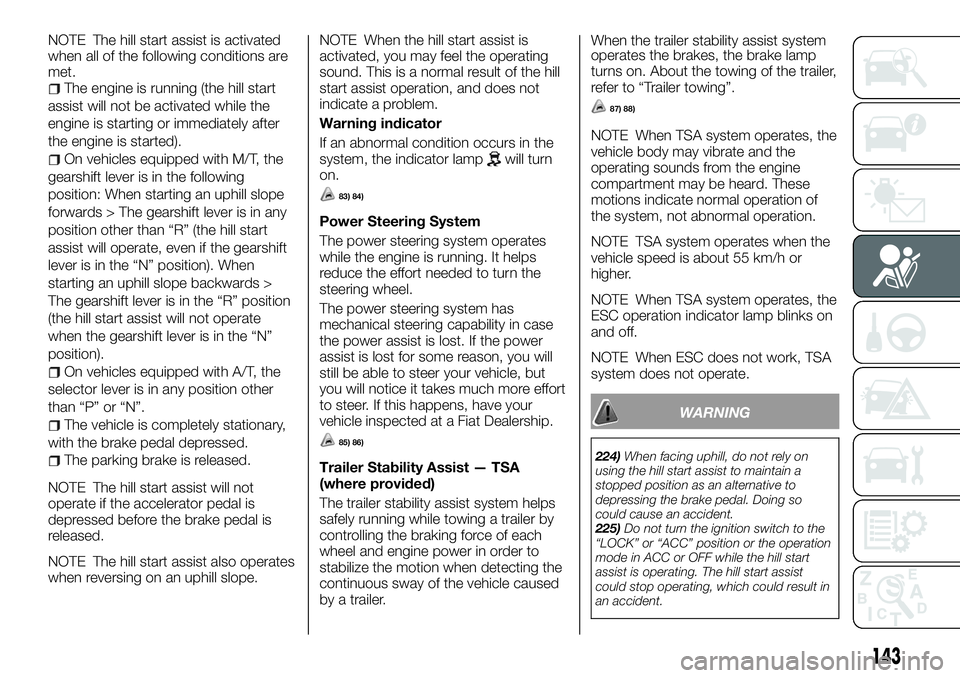
NOTE The hill start assist is activated
when all of the following conditions are
met.
The engine is running (the hill start
assist will not be activated while the
engine is starting or immediately after
the engine is started).
On vehicles equipped with M/T, the
gearshift lever is in the following
position: When starting an uphill slope
forwards > The gearshift lever is in any
position other than “R” (the hill start
assist will operate, even if the gearshift
lever is in the “N” position). When
starting an uphill slope backwards >
The gearshift lever is in the “R” position
(the hill start assist will not operate
when the gearshift lever is in the “N”
position).
On vehicles equipped with A/T, the
selector lever is in any position other
than “P” or “N”.
The vehicle is completely stationary,
with the brake pedal depressed.
The parking brake is released.
NOTE The hill start assist will not
operate if the accelerator pedal is
depressed before the brake pedal is
released.
NOTE The hill start assist also operates
when reversing on an uphill slope.NOTE When the hill start assist is
activated, you may feel the operating
sound. This is a normal result of the hill
start assist operation, and does not
indicate a problem.
Warning indicator
If an abnormal condition occurs in the
system, the indicator lamp
will turn
on.
83) 84)
Power Steering System
The power steering system operates
while the engine is running. It helps
reduce the effort needed to turn the
steering wheel.
The power steering system has
mechanical steering capability in case
the power assist is lost. If the power
assist is lost for some reason, you will
still be able to steer your vehicle, but
you will notice it takes much more effort
to steer. If this happens, have your
vehicle inspected at a Fiat Dealership.
85) 86)
Trailer Stability Assist — TSA
(where provided)
The trailer stability assist system helps
safely running while towing a trailer by
controlling the braking force of each
wheel and engine power in order to
stabilize the motion when detecting the
continuous sway of the vehicle caused
by a trailer.When the trailer stability assist system
operates the brakes, the brake lamp
turns on. About the towing of the trailer,
refer to “Trailer towing”.
87) 88)
NOTE When TSA system operates, the
vehicle body may vibrate and the
operating sounds from the engine
compartment may be heard. These
motions indicate normal operation of
the system, not abnormal operation.
NOTE TSA system operates when the
vehicle speed is about 55 km/h or
higher.
NOTE When TSA system operates, the
ESC operation indicator lamp blinks on
and off.
NOTE When ESC does not work, TSA
system does not operate.
WARNING
224)When facing uphill, do not rely on
using the hill start assist to maintain a
stopped position as an alternative to
depressing the brake pedal. Doing so
could cause an accident.
225)Do not turn the ignition switch to the
“LOCK” or “ACC” position or the operation
mode in ACC or OFF while the hill start
assist is operating. The hill start assist
could stop operating, which could result in
an accident.
143
Page 146 of 316
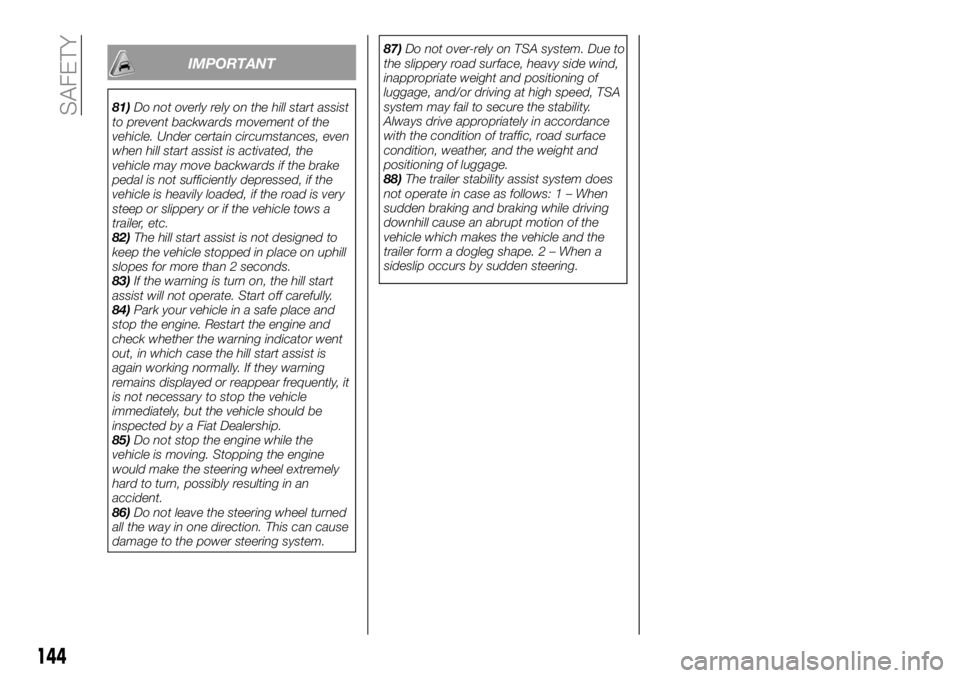
IMPORTANT
81)Do not overly rely on the hill start assist
to prevent backwards movement of the
vehicle. Under certain circumstances, even
when hill start assist is activated, the
vehicle may move backwards if the brake
pedal is not sufficiently depressed, if the
vehicle is heavily loaded, if the road is very
steep or slippery or if the vehicle tows a
trailer, etc.
82)The hill start assist is not designed to
keep the vehicle stopped in place on uphill
slopes for more than 2 seconds.
83)If the warning is turn on, the hill start
assist will not operate. Start off carefully.
84)Park your vehicle in a safe place and
stop the engine. Restart the engine and
check whether the warning indicator went
out, in which case the hill start assist is
again working normally. If they warning
remains displayed or reappear frequently, it
is not necessary to stop the vehicle
immediately, but the vehicle should be
inspected by a Fiat Dealership.
85)Do not stop the engine while the
vehicle is moving. Stopping the engine
would make the steering wheel extremely
hard to turn, possibly resulting in an
accident.
86)Do not leave the steering wheel turned
all the way in one direction. This can cause
damage to the power steering system.87)Do not over-rely on TSA system. Due to
the slippery road surface, heavy side wind,
inappropriate weight and positioning of
luggage, and/or driving at high speed, TSA
system may fail to secure the stability.
Always drive appropriately in accordance
with the condition of traffic, road surface
condition, weather, and the weight and
positioning of luggage.
88)The trailer stability assist system does
not operate in case as follows: 1 – When
sudden braking and braking while driving
downhill cause an abrupt motion of the
vehicle which makes the vehicle and the
trailer form a dogleg shape. 2 – When a
sideslip occurs by sudden steering.
144
SAFETY
Page 147 of 316
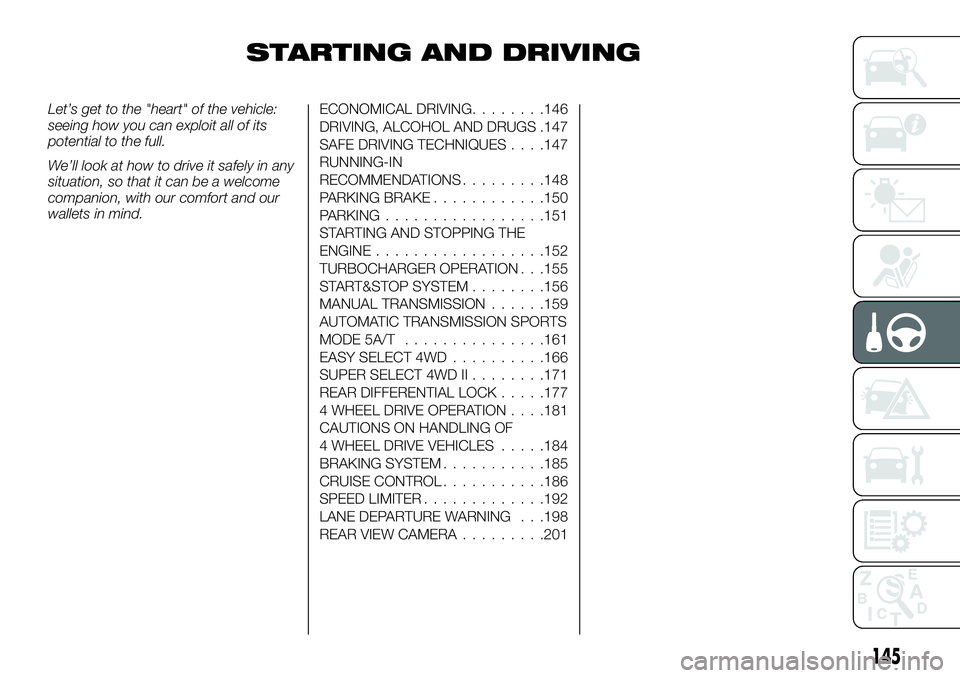
STARTING AND DRIVING
Let’s get to the "heart" of the vehicle:
seeing how you can exploit all of its
potential to the full.
We’ll look at how to drive it safely in any
situation, so that it can be a welcome
companion, with our comfort and our
wallets in mind.ECONOMICAL DRIVING........146
DRIVING, ALCOHOL AND DRUGS .147
SAFE DRIVING TECHNIQUES. . . .147
RUNNING-IN
RECOMMENDATIONS.........148
PARKING BRAKE............150
PARKING.................151
STARTING AND STOPPING THE
ENGINE..................152
TURBOCHARGER OPERATION . . .155
START&STOP SYSTEM........156
MANUAL TRANSMISSION......159
AUTOMATIC TRANSMISSION SPORTS
MODE 5A/T...............161
EASY SELECT 4WD..........166
SUPER SELECT 4WD II........171
REAR DIFFERENTIAL LOCK.....177
4 WHEEL DRIVE OPERATION. . . .181
CAUTIONS ON HANDLING OF
4 WHEEL DRIVE VEHICLES.....184
BRAKING SYSTEM...........185
CRUISE CONTROL...........186
SPEED LIMITER.............192
LANE DEPARTURE WARNING . . .198
REAR VIEW CAMERA.........201
145
Page 148 of 316
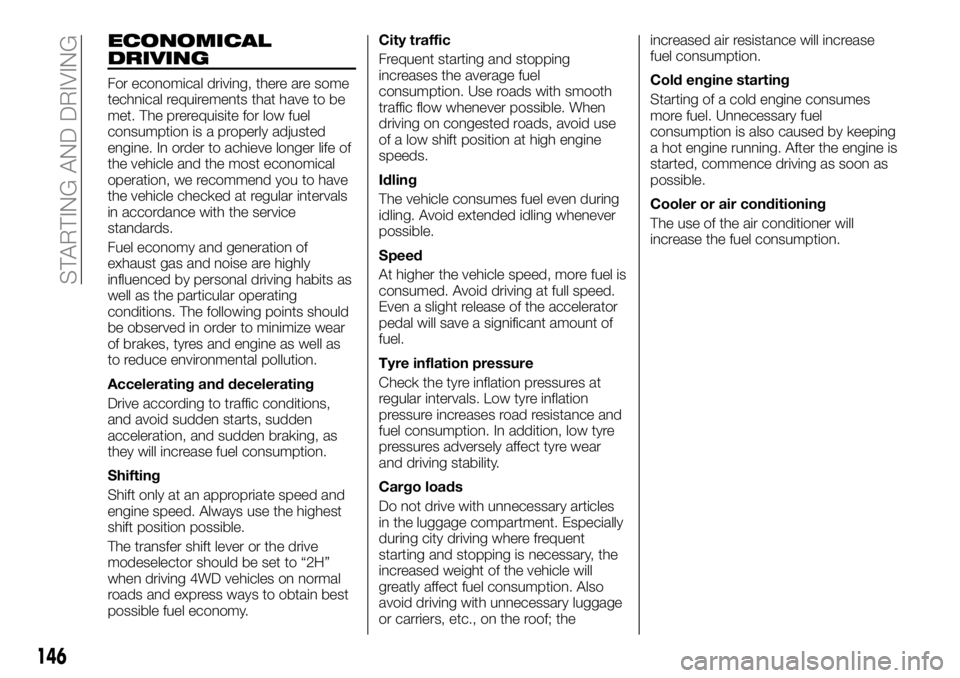
ECONOMICAL
DRIVING
For economical driving, there are some
technical requirements that have to be
met. The prerequisite for low fuel
consumption is a properly adjusted
engine. In order to achieve longer life of
the vehicle and the most economical
operation, we recommend you to have
the vehicle checked at regular intervals
in accordance with the service
standards.
Fuel economy and generation of
exhaust gas and noise are highly
influenced by personal driving habits as
well as the particular operating
conditions. The following points should
be observed in order to minimize wear
of brakes, tyres and engine as well as
to reduce environmental pollution.
Accelerating and decelerating
Drive according to traffic conditions,
and avoid sudden starts, sudden
acceleration, and sudden braking, as
they will increase fuel consumption.
Shifting
Shift only at an appropriate speed and
engine speed. Always use the highest
shift position possible.
The transfer shift lever or the drive
modeselector should be set to “2H”
when driving 4WD vehicles on normal
roads and express ways to obtain best
possible fuel economy.City traffic
Frequent starting and stopping
increases the average fuel
consumption. Use roads with smooth
traffic flow whenever possible. When
driving on congested roads, avoid use
of a low shift position at high engine
speeds.
Idling
The vehicle consumes fuel even during
idling. Avoid extended idling whenever
possible.
Speed
At higher the vehicle speed, more fuel is
consumed. Avoid driving at full speed.
Even a slight release of the accelerator
pedal will save a significant amount of
fuel.
Tyre inflation pressure
Check the tyre inflation pressures at
regular intervals. Low tyre inflation
pressure increases road resistance and
fuel consumption. In addition, low tyre
pressures adversely affect tyre wear
and driving stability.
Cargo loads
Do not drive with unnecessary articles
in the luggage compartment. Especially
during city driving where frequent
starting and stopping is necessary, the
increased weight of the vehicle will
greatly affect fuel consumption. Also
avoid driving with unnecessary luggage
or carriers, etc., on the roof; theincreased air resistance will increase
fuel consumption.
Cold engine starting
Starting of a cold engine consumes
more fuel. Unnecessary fuel
consumption is also caused by keeping
a hot engine running. After the engine is
started, commence driving as soon as
possible.
Cooler or air conditioning
The use of the air conditioner will
increase the fuel consumption.
146
STARTING AND DRIVING